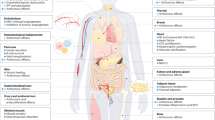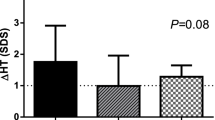Abstract
Growth hormone (GH)-releasing hormone (GHRH) is the most important stimulus for GH secretion by the pituitary gland. Subjects homozygous for GHRH receptor (GHRHR) gene (GHRHR) inactivating mutations have severe GH deficiency, resulting in severe short stature if not treated. We previously reported that young adults heterozygous for the c.57+1G>A null GHRHR mutation (MUT/N) have reduced weight and body mass index (BMI) but normal stature. Here we have studied whether older MUT/N have an additional phenotype. In a cross-sectional study, we measured height, weight and blood pressure, and calculated BMI in two groups (young, 20–40 years of age) and old (60–80 years) of individuals heterozygous for the same GHRHR mutation, and compared with a large number of individuals of normal genotype residing in the same geographical area. Standard deviation score (SDS) of weight was lower, and BMI had a trend toward reduction in young heterozygous compared with young normals, without significant difference in stature. Conversely, SDS of height was lower in older heterozygous individuals than in controls, corresponding to a reduction of 4.2 cm. These data show a reduced stature in older subjects heterozygous for the c.57+1G>A GHRHR mutation, indicating different effects of heterozygosis through lifespan.
Similar content being viewed by others
Log in or create a free account to read this content
Gain free access to this article, as well as selected content from this journal and more on nature.com
or
References
Jull, A., Bang, P., Hertel, N. T., Main, K., Dalgaard, P. & Jørgensen, K et al. Serum insulin-like growth factor-I in 1030 healthy children, adolescents, and adults: relation to age, sex, stage of puberty, testicular size, and body mass index. J. Clin. Endocrinol. Metab. 78, 744–752 (1994).
Abellan Van Kan, G., Rolland, Y., Houles, M., Gillette-Guyonnet, S., Soto, M. & Vellas, B. The assessment of frailty in older adults. Clin. Geriatr. Med. 26, 275–286 (2010).
Huang, C., Ross, P. D., Lydick, E., Davis, J. W. & Wasnich, R. D. Contributions of vertebral fractures to stature loss among elderly Japanese-American women in Hawaii. J. Bone. Miner. Res. 11, 408–411 (1996).
Liu, Y.-Z., Xiao, P., Guo, Y. F., Xiong, D. H., Zhao, L. J. & Shen, H. et al. Genetic linkage of human height is confirmed to 9q22 and Xq24. Hum. Genet. (2006) 119, 295–304.
Lango Allen, H., Estrada, K., Lettre, G., Berndt, S. I., Weedon, M. N. & Rivadeneira, F. et al. Hundreds of variants clustered in genomic loci and biological pathways affect human height. Nature 467, 832–838 (2010).
Martari, M. & Salvatori, R. Diseases associated with growth hormone‐releasing hormone receptor (GHRHR) mutations. Prog. Mol. Biol. Transl. Sci. 88, 57–84 (2009).
Johansson, A., Jonasson, I. & Gyllensten, U. Extended haplotypes in the growth hormone releasing hormone receptor gene (GHRHR) are associated with normal variation in height. PloS One 4, e446 (2009).
Salvatori, R., Hayashida, C. Y., Aguiar-Oliveira, M. H., Phillips, J. A. III, Souza, A. H. & Gondo, R. G. et al. Familial isolated growth hormone deficiency due to a novel mutation in the growth hormone releasing hormone receptor. J. Clin. Endocrinol. Metab. 84, 917–923 (1999).
Marui, S., Trarbach, E. B., Boguszewski, M. C., França, M. M., Jorge, A. A. & Inoue, H. et al. GH-releasing hormone receptor gene: a novel splice-disrupting mutation and study of founder effects. Horm. Res. Paediatr. 78, 165–172 (2012).
Barreto-Filho, J. A., Alcântara, M. R.S., Salvatori, R., Azevedo, M., Barreto, M. & Sousa, A. C. et al. Familial isolated growth hormone deficiency is associated with increased systolic blood pressure, dyslipidemia and central obesity. J. Clin. Endocrinol. Metab. 87, 2018–2023 (2002).
Epitácio-Pereira, C. C., Silva, G. M., Salvatori, R., Santana, J. A., Pereira, F. A. & Gois-Junior, M. B. et al. Isolated GH deficiency due to a GHRH receptor mutation causes hip joint problems and genu valgum, and reduces size, but not density of trabecular and mixed bone. J. Clin. Endocrinol. Metab. 11, E1710–E1715 (2013).
Souza, A. H.O., Farias, M. I.T., Salvatori, R., Silva, G. M.F., Santana, J. A.M. & Pereira, C. R. P. et al. Lifetime, untreated isolated GH deficiency due to a GH-releasing hormone receptor mutation has beneficial consequences on bone status in older individuals, and does not influence their abdominal aorta calcification. Endocrine 47, 191–197 (2014).
Maheshawari, H. G., Silverman, B. L., Dupuis, J. & Baumann, G. Phenotype and genetic analysis of a syndrome caused by an inactivating mutation in the growth hormone-releasing hormone receptor: dwarfism of Sindh. J. Clin. Endocrinol. Metab. 83, 4065–4074 (1998).
Leiberman, E., Pesler, D., Parvari, R., Elbedour, K., Abdul-Latif, H., Brown, M. R., Parks, J. S. & Carmi, R. Short stature in carriers of recessive mutation causing familial isolated growth hormone deficiency. Am. J. Med. Genet. 90, 188–192 (2000).
Pereira, R. M.C., Aguiar-Oliveira, M. H., Sagazio, A., Oliveira, C. R., Oliveira, F. & Campos, V. C. et al. Heterozygosity for a mutation in the growth hormone-releasing hormone receptor gene does not influence adult stature, but affects body composition. J. Clin. Endocrinol. Metab. 92, 2353–2357 (2007).
Aguiar-Oliveira, M. H., Oliveira, F. T., Pereira, R. M.C., Oliveira, C. R., Blackford, A. & Valença, E. H. et al. Longevity in untreated congenital growth hormone deficiency due to a homozygous mutation in the GHRH receptor gene. J. Clin. Endocrinol. Metab. 95, 4000–4008 (2010).
Brown, E. M. Clinical lessons from the calcium-sensing receptor. Nat. Clin. Pract. Endocrinol. Metab. 3, 122–133 (2007).
Olney, R. C., Bükülmez, H., Bartels, C. F., Prickett, T. C., Espiner, E. A. & Potter, L. R. et al. Heterozygous mutations in natriuretic peptide receptor-B (NPR2) are associated with short stature. J. Clin. Endocrinol. Metab. 91, 1229–1232 (2006).
Farooqi, L. S., Keogh, J. M., Yeo, G. S., Lank, E. J., Cheetham, T. & O’Rahilly, S. Clinical spectrum of obesity and mutations in the melanocortin 4 receptor gene. N. Engl. J. Med. 348, 1085–1095 (2003).
Sanchez, J. E., Perera, E., Baumbach, L. & Cleveland, W. W. Growth hormone receptor mutations in children with idiopathic short stature. J. Clin. Endocrinol. Metab. 83, 4079–4083 (1988).
Buffa, R., Floris, G. U., Putzu, P. F. & Marini, E. Body composition variations in ageing. Coll. Antropol. 35, 259–265 (2011).
Pena, S. D., Di Pietr,o, G., Fuchshuber-Moraes, M., Pasqualini Genro, J., Hutz, M. H. & de Souza, Gomes Kehdy, F. et al. The genomic ancestry of individuals from different geographical regions of Brazil is more uniform than expected. PLoS ONE 16, e17063 (2011).
Schoenau, E. From mechanostat theory to development of the ‘Functional Muscle-Bone-Unit’. J. Musculoskelet. Neuronal. Interact. 5, 232–238 (2007).
Giustina, A., Mazziotti, G. & Canalis, E. Growth hormone, insulin like Growth factors and the skeleton. Endocr. Rev. 29, 535–539 (2008).
Hogler, W. & Shaw, N. Childhood growth hormone deficiency, bone density, structures and fractures: scrutinizing the evidence. Clin. Endocrinol. (Oxf.) 72, 281–289 (2010).
Acknowledgements
We thank the Court of Electoral Justice of Sergipe estate and the Catholic Roman and First Baptist churches in Itabaianinha for allowing us to perform this work.
Author information
Authors and Affiliations
Corresponding author
Ethics declarations
Competing interests
The authors declare no conflict of interest.
Rights and permissions
About this article
Cite this article
Aguiar-Oliveira, M., Cardoso-Filho, M., MC Pereira, R. et al. Older individuals heterozygous for a growth hormone-releasing hormone receptor gene mutation are shorter than normal subjects. J Hum Genet 60, 335–338 (2015). https://doi.org/10.1038/jhg.2015.25
Received:
Revised:
Accepted:
Published:
Issue date:
DOI: https://doi.org/10.1038/jhg.2015.25
This article is cited by
-
The role of GPCRs in bone diseases and dysfunctions
Bone Research (2019)



